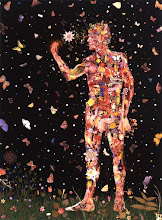 The other day I received a small package from Spain. It was the third edition of a work titled La psicología de los artistas, by Santiago Ramón y Cajal. It includes a number of pieces, including an account of Cajal's childhood as told by his brother [and fellow neuroscientist] Pedro, letters written by Cajal himself, and a literary essay concerning Cervantes's Don Quixote. To my knowledge, the content has never been translated into English. Therefore I am endeavoring to do so, starting with that essay titled "El quijote y el quijotismo," written in 1905 in commemoration of the publication of "the immortal book" [to use Cajal's words].
The other day I received a small package from Spain. It was the third edition of a work titled La psicología de los artistas, by Santiago Ramón y Cajal. It includes a number of pieces, including an account of Cajal's childhood as told by his brother [and fellow neuroscientist] Pedro, letters written by Cajal himself, and a literary essay concerning Cervantes's Don Quixote. To my knowledge, the content has never been translated into English. Therefore I am endeavoring to do so, starting with that essay titled "El quijote y el quijotismo," written in 1905 in commemoration of the publication of "the immortal book" [to use Cajal's words].So far I have translated [roughly] roughly all of the first half: "El quijote." It is a fascinating piece from a refreshingly extra-disciplinary perspective written in the romantic style that captured Cajal's heart at a young age. Here is the first paragraph:
"Universally admired is the eminent moral figure of the noble la Manchan don Alonso Quijano el Bueno; converted to knight-errantry by suggestion of silly chivalresque books, he represents, as it has been said a thousand times, the most perfect symbol of honor and altruism. Ever Anglo-Saxon in nature, so given to imagining energetic and original characters, he invented a most exquisite persona of indomitable individualism and sublime self-denial."
Cajal considers "el Quijote," literally "the Do-Gooder," an archetype. In fact, one of the sections of the essay's second part is called "Representative Men. Men of the Species." A key word in the above paragraph is "suggestion" [sugestión], which is a most powerful notion. Cajal was fascinated by the popular pseudo-science of hypnotism—he even conducted his own investigative experiments on the topic—because of its apparent influence on the mind. Suggestion, then, is a weapon of falsity. Golgi and other proponents of the reticular theory were given to such convincing aspects of un-reality as ego and convention. Moreover, I love the phrase "sublime self-denial." Although it refers to Quixote's insane ignorance, it also has serious spiritual implications.
Now, what is most interesting about this essay in my opinion is that it is implicitly personal. Cervantes's classic was one of the treasures the teenage Cajal found in his neighbor's stash of romantic materials. But, then, Cajal objected to the author's treatment of his hero. Cajal was himself quite quixotic, and that quality would never truly leave him. In his autobiography, he refers at least twice to the famous character. By the time he wrote Advice for a Young Investigator, Cajal agreed that a combination of the temperaments of don Quixote and Sancho Panza. Indeed, Cajal calls one of the essay's sections "Salute to Sancho Panza," "prodigious incarnation of the tranquility and goodness of the soul." Though naturally an idealist, like his sympathetic literary hero, Cajal understood the necessary balance of healthy character. One must control "el Quijote."
This critical essay, which relies on a biographical and psychological reading, is an extremely insightful one in my opinion. So far, I think it is definitely worthwhile given the genius of its author. We'll see what happens when I finish translating and polishing.
Happy Thanksgiving!







